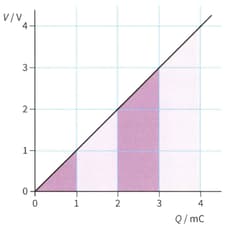Calculate the average current required to charge a $50 \mu \mathrm{F}$ capacitor to a potential difference of $10 \mathrm{~V}$ in a time interval of $0.01 \mathrm{~s}$

Important Questions on Capacitance
A student connects an uncharged capacitor of capacitance In series with a resistor, a cell and a switch. The student closes the switch and records the current At intervals of 10s. The results are shown in table. The potential difference across the capacitor after was . Plot a current–time graph, and use it to estimate the value of .
| t /s | 0 | 10 | 20 | 30 | 40 | 50 | 60 |
| 1 / µA | 200 | 142 | 102 | 75 | 51 | 37 | 27 |
State the quantity represented by the gradient of the straight line shown in Figure.

The area under a graph of voltage against charge gives a quantity of energy. The area in figure shows the energy stored in a capacitor; the area in figure shows the energy required to drive a charge through a resistor.
The graph of Figure shows how Depends on For a particular capacitor.

The energy stored by a capacitor is equal to the area under the graph of voltage against charge.
The area under the graph has been divided into strips to make it easy to calculate the energy stored. The first strip (which is simply a triangle) shows the energy stored when the capacitor is charged up to . The energy stored is . Calculate the capacitance Of the capacitor.
Calculate the total capacitance of two capacitors connected in parallel.
You have a number of identical capacitors, each of capacitance . Determine the total capacitance when:
Two capacitors are connected in series.
